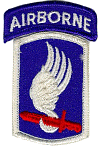|
|
|

March 26, 1963 -- On the island of Okinawa, the only separate Airborne Brigade to exist in the history of the US Army was activated. This was the 173d Airborne Brigade (Separate).
Formed to be what would be called in today's jargon a quick-reaction force for the protection of American interests in Asia, the Brigade underwent extensive jungle training on Okinawa and Irimote. This was followed by parachute jumps in the Philippines; Thailand and Taiwan.
During the Taiwan exercises, the locals gave the paratroops of the 173d the nickname "Tien Bing" (Chinese for Sky Soldier). "The Sky Soldiers" became the official nickname of the Brigade and was commonly used in Brigade newsletters and press releases. A more popular nickname is one that originated from some anonymous pundit in the ranks - "The Herd."
On May 5, 1965, the Brigade deployed to South Viet Nam as the first US Army ground combat unit in that war.
Upon arrival, one battalion of the Royal Australian Army and a battery from New Zealand were attached to the Brigade -- making the 173d Airborne the only multi-national combat unit in the war.
Initially headquartered in Bien Hoa, the Brigade operated in the four provinces around Saigon. (Xuan Loc, Long Khanh, Phuoc Long & Phuoc Tuy), but (in its roll as a "Fire Brigade") also went to the Central Highlands (Pleiku/Kontum) to fight Viet Cong.
The 173d also conducted constant operations against the southern stronghold of the VC Main Force in the legendary Iron Triangle in War Zone D. The 1/503rd battalion won the brigade it's first unit citation of the war on November 8,1965 in War Zone 'D' during Operation Hump better known as the Battle of Hill 65. By then, two members of the brigade had already won the Medal of Honor. A third was won during Operation Hump [Information provided by John 'Dutch' Holland, B/1/503 65-66].
At 0900 Hours, February 22, 1967 (during Operation Junction City) over 800 paratroopers jumped into the rice paddies at Katum in War Zone C. The same unit (plus attached combat engineers and artillerymen) that had made the famous jump on the Island of Corregidor (2/503d) during WW2, made the first and only full-sized combat jump by an American unit (there were Vietnamese jumps of course and some small unit jumps by USMC's Force Recon as well).
Once on the ground, the paratroopers joined the Brigade in cutting off VC units fleeing a massive sweep by the 1st, 4th, and 25th Infantry Divisions, and the 11th Armored Cavalry regiment.
In the summer of 1967, the Brigade saw extensive and bloody action in the Central Highlands near Kontum, Pleiku, Dak To.
In mid-November of 1967, the 2d Battalion of the 503d Airborne Infantry pushed units of the 1st and 10th North Vietnamese Army Divisions towards the Cambodian/Laotian borders. To cover their retreat into these sanctuaries the elite NVA 174th Infantry Regiment was deeply entrenched in a complex of fortified bunkers on Hill 875, near Dak To. On November 6th, two companies from 4th battalion encountered elements of the NVA 66th Regiment south of Ben Het and in a fierce firefight lost 7 men. On November 11th (Veteran's Day), Charlie Company and two platoons from Delta Company 1/503 were ambushed with 20 killed and 154 wounded. PFC John Barnes received the CMH for his actions during this ambush.
On November 19th, 1967, the 2d Battalion of the 503d Airborne Infantry was ordered to clear Hill 875. Resistance by the communists was intense and the 4th Battalion of the 503d joined 2nd battalion in its efforts.
Four days later, on Thanksgiving Day, after some of the bloodiest fighting of the war, the survivors of the 2d and 4th Battalions finally reached the summit. Chaplain Watters and PFC Carlos Lozada received the CMH for their heroism on Hill 875. The 2nd battalion lost 107 men killed and 282 wounded and 10 MIA.
In 1968 the majority of the Brigade was stationed in the province of Binh Dinh. Operations were also conducted in the Central Highlands and near Ban Me Thout.
For the next four years the Brigade conducted operations against VC/NVA forces. Not as frequently noted as it should be, the Herd also provided security for medical teams involved in MEDCAP; training of indigenous forces for self-defense; and other programs designed to undermine the VC infrastructure in the rich rice-growing lands of the Coastal Plain. Emphasis was on small unit patrols and combined operations with ARVN/MSF/RF-PF units.
The 173d Airborne Brigade took part in 14 designated campaigns in RVN. It remained in combat longer than any other American military unit since the Revolutionary War. It earned four unit citations, had 12 Medal of Honor winners, 1601 Sky Soldiers were killed in action and another 8,435 were wounded in action.
The 10,041 casualties incurred by the Brigade were five times greater than those suffered by the 187th Airborne Regiment in Korea, four times greater than those suffered by the 11th Airborne Division in the Pacific during World War II, more than twice those suffered by the 101st Airborne Division in Europe in World War II, and two-thirds of those suffered by the entire 82nd Airborne Division in WW2.
In September 1971 the Brigade was redeployed to Fort Campbell, Kentucky and subsequently on January, 14, 1972 was deactivated.
In 1986, the 1/503rd was reactivated as an Air Assault unit and presently is attached to the 2nd Infantry Division in Korea. It was the last U.S. unit to patrol the Korean DMZ (information provided by SSG Matthew Olsen who served with the battalion at Camp Casey in 1997-98).
 |
|||||||||||||||||||||||||||||||||||||||||||||||||||||||||||||||||||||||||||||||||||||||||||||||||||||||||||||||||||||||||||||||||||||||||||||||||||||||||||||||